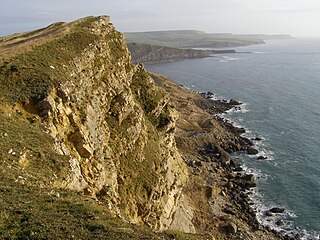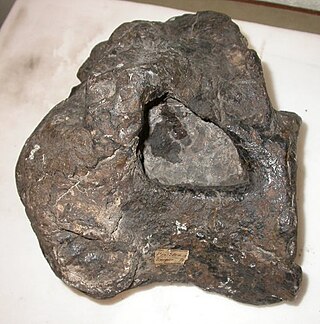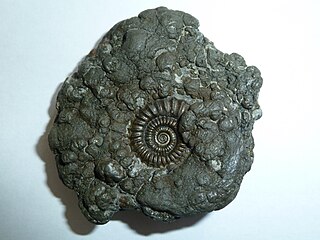
The Jurassic Coast is a World Heritage Site on the English Channel coast of southern England. It stretches from Exmouth in East Devon to Studland Bay in Dorset, a distance of about 96 miles (154 km), and was inscribed on the World Heritage List in mid-December 2001.

Plesiosaurus is a genus of extinct, large marine sauropterygian reptile that lived during the Early Jurassic. It is known by nearly complete skeletons from the Lias of England. It is distinguishable by its small head, long and slender neck, broad turtle-like body, a short tail, and two pairs of large, elongated paddles. It lends its name to the order Plesiosauria, of which it is an early, but fairly typical member. It contains only one species, the type, Plesiosaurus dolichodeirus. Other species once assigned to this genus, including P. brachypterygius, P. guilielmiimperatoris, and P. tournemirensis have been reassigned to new genera, such as Hydrorion, Seeleyosaurus and Occitanosaurus.

Scelidosaurus is a genus of herbivorous armoured ornithischian dinosaur from the Jurassic of England.

Ornithopsis is a genus of sauropod dinosaur, from the Early Cretaceous of England and possibly Germany. The type species, which is the only species seen as valid today, is O. hulkei, which is only known from fragmentary remains.

Dapedium is an extinct genus of primitive marine neopterygian ray-finned fish. The first-described finding was an example of D. politum, found in the Lower Lias of Lyme Regis, on the Jurassic Coast of England. Dapedium lived in the Late Triassic to the Middle Jurassic period, from the late Norian to the early Aalenian.

Attenborosaurus is an extinct genus of pliosaurid from the Early Jurassic of Dorset, England. The type species is A. conybeari. The genus is named after David Attenborough, the species after William Conybeare.

Blapsium is an extinct genus of beetles from the Middle Jurassic of England. The only described species is B. egertoni, which is known from a single specimen found by the Earl of Enniskillen at the Taynton Limestone Formation, also known as the Stonesfield Slate. The specimen is deposited in the Natural History Museum, London. It is incompletely preserved, lacking a head, pronotum and legs. It has a broad, convex body. It has a very short metathorax, which suggests that it was possibly apterous.

Kimmerosaurus is an extinct genus of plesiosaur from the family Cryptoclididae. Kimmerosaurus is most closely related to Tatenectes.

The Blue Lias is a geological formation in southern, eastern and western England and parts of South Wales, part of the Lias Group. The Blue Lias consists of a sequence of limestone and shale layers, laid down in latest Triassic and early Jurassic times, between 195 and 200 million years ago. The Blue Lias is famous for its fossils, especially ammonites.

Eretmosaurus is an extinct genus of plesiosaur from the Early Jurassic Blue Lias of England. Only the type species is known, which is E. rugosus.

Promicroceras is an extinct ammonite genus from the upper Sinemurian of Europe, named by Leonard Spath in 1925. Promicroceras is included in the family Eoderoceratidae, which is part of the ammonitid superfamily Eoderoceratoidea.

Archaeolepis mane is amongst the earliest undisputed lepidopteran fossils. It dates from the Lower Jurassic. It was found in the Charmouth Mudstone Formation, Dorset, United Kingdom.

Palaeontinidae, commonly known as giant cicadas, is an extinct family of cicadomorphs. They existed from the Late Triassic to the Early Cretaceous. The family contains around 30 to 40 genera and around a hundred species.
Brochocoleus is an extinct genus of beetles in the family Ommatidae, known from the Early Jurassic to the Early Late Cretaceous. 9 species are currently recognised, with many species being reassigned to other genera by Kirejtshuk's major systematic revision in 2020.

Omma is a genus of beetles in the family Ommatidae. Omma is an example of a living fossil. The oldest species known, O. liassicum, lived during the final stage of the Triassic (Rhaetian), over 200 million years ago, though the placement of this species in Omma has been questioned. Numerous other fossil species are known from the Jurassic and Cretaceous of Europe and Asia. The only living species is Omma stanleyi, which is endemic to Australia. Three other extant species endemic to Australia that were formerly part of this genus were moved to the separate genus Beutelius in 2020.Omma stanleyi is strongly associated with wood, being found under Eucalyptus bark and exhibiting thanatosis when disturbed. Its larval stage and many other life details are unknown due to its rarity. Males are typically 14–20 mm in length, while females are 14.4-27.5 mm. Omma stanleyi occurs throughout eastern Australia from Victoria to Central Queensland.
Priscaenigma is an extinct genus of snakefly of the Priscaenigmatidae family which was described by Whalley in 1985. The fossils were found on flatstones at Black Ven in Charmouth, Dorset at 50.7°N 2.9°W in a marine environment of the Charmouth Mudstone Formation. The fossils were collected by J. F. Jackson between 1961 and 1963. Its sister taxa is Hondelagia. The genus contains one species, the extinct Priscaenigma obtusa, also described by Whalley in 1985. Its forewing is 12.6 centimetres (5.0 in) in length. Only a forewing was found when the species was discovered.

The Stenophlebiidae is an extinct family of medium-sized to large fossil odonates from the Upper Jurassic and Cretaceous period that belongs to the damsel-dragonfly grade ("anisozygopteres") within the stem group of Anisoptera. They are characterized by their long and slender wings, and the transverse shape of the discoidal triangles in their wing venation.

The Charmouth Mudstone Formation is a geological formation in England, dating to the Early Jurassic (Sinemurian–Pliensbachian). It forms part of the lower Lias Group. It is most prominently exposed at its type locality in cliff section between Lyme Regis and Charmouth but onshore it extends northwards to Market Weighton, Yorkshire, and in the subsurface of the East Midlands Shelf and Wessex Basin. The formation is notable for its fossils, including those of ammonites and marine reptiles and rare dinosaur remains. The formation played a prominent role in the history of early paleontology, with its Lyme Regis-Charmouth exposure being frequented by fossil collectors including Mary Anning.
Fulgoridiidae are an extinct family of Mesozoic planthoppers. They are the earliest group of planthoppers known, and appear to be a paraphyletic assemblage ancestral to living planthoppers. The majority of known members of the family lived in the Jurassic period, though the group also includes one Cretaceous taxon. All currently known species are from Eurasia.

Dornraptor is an extinct genus of averostran, possibly stem tetanuran, theropod dinosaur from the Early Jurassic of Charmouth, Dorset, England. The genus contains a single species, D. normani, known from a fragmentary knee joint and femur that were initially described by Sir Richard Owen as belonging to the early armored dinosaur Scelidosaurus. Dornraptor lived in what is now England, along other theropods like Dracoraptor and Sarcosaurus.
















